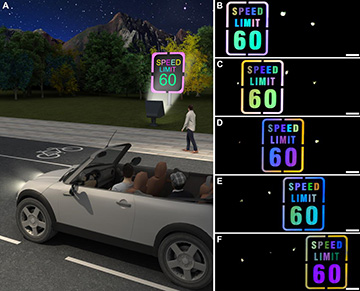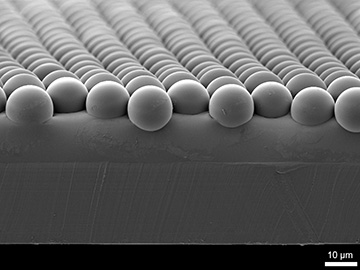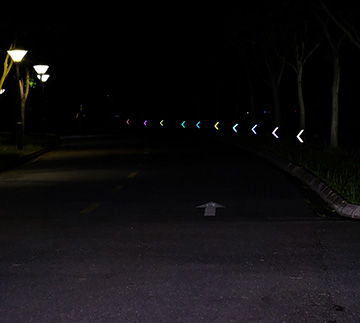
Researchers in China and the U.S. have developed a cheap-to-manufacture, structural-color film that enables shifting, retroreflected colors at a wide range different viewing angles. The film could be used to create “interactive” road signs whose colors change when approached and passed by a moving vehicle. [Image: Fan et al., Sci. Adv. 5, eaaw8755 (2019); CC-BY-NC]
Optical scientists and engineers in China and the United States have cooked up a cheap, simple yet intriguing material that could add tunable structural colors, visible at a wide range of angles, to the kind of retroreflective displays used for highway speed-limit signs, billboards and other applications (Sci. Adv., doi: 10.1126/sciadv.aaw8755). The research team believes that the material—essentially a piece of transparent sticky tape coated with a single layer of polymer microspheres—could find use in highway safety, anti-counterfeiting technology and more.
Retroreflectivity’s color problem
For many years, road signs have used tiny, embedded glass beads to add a retroreflective glow when the sign is illuminated by an approaching car’s headlights. Commonly, color is added to such signs through dyes and pigments beneath the retroreflective layer. Those colors, however, tend to fade over time, can require hazardous materials to produce, and lack the ability to give a different response depending on viewing angle.
A structural-color material—in which color arises from interference effects of nanostructures in the material, like the tiny scales that give rise to the brilliant colors on a butterfly’s wing—in principle could add a range of iridescent colors to such retroreflective signs. But while structural-color research has been an active area of nanoscience in recent years, resulting in some seriously cool demos, the brilliantly iridescent structural colors that have attracted attention in recent engineering tend to be viewable only at a limited range of angles close to the incidence angle of the illuminating light.
Microspheres on tape
The team behind the new research—including scientists and engineers at Fudan University, Shanghai, China, and the State University of New York, Buffalo, USA, and led by Limin Wu at Fudan—found a way around these difficulties by fashioning a structural-color film that seems, superficially at least, to be quite simple. The researchers started by using a previously developed, inexpensive chemical method, colloidal assembly, to put down a monolayer of commercially available, 15-μm-diameter microspheres on a poly(dimethylsiloxane) (PDMS) substrate. They then used a sheet of transparent adhesive “sticky tape,” roughly 40 μm in thickness, to pull the arrayed microspheres off of the substrate.

The retroreflective structural-color film consists of a monolayer of microspheres, embedded in sheet of clear sticky tape. [Image: Wen Fan et al., Fudan University]
The result was a thin, transparent sheet of microsphere-embedded adhesive material that remained transparent when illuminated by diffuse light, such as sunlight or light from an incandescent bulb. When illuminated by directional light, such as a white LED flashlight, however, the previously transparent tape instead reflected a bright, steady blue color.
The team also found that while the uniform blue reflection was visible in coaxial light—that is, when the direction of the illumination and the observer’s viewing angle were the same—the retroreflected iridescent color changed when the observer was viewing at a different angle from the angle of illumination, across a broad range of angles. And the reflected color and color effects could be tuned by varying the size of the microspheres used.
Color-changing road safety signs
To better characterize what was going on, the researchers dug into the properties of the material by studying it with an optical microscope at 700× magnification. They suggest that the film’s unusual color properties can be explained by “a previously unidentified interferometric retroreflection mechanism” that involves not just the effect of the microspheres, but also the presence of a tiny, uniform air gap that forms between the sphere and the sticky layer. If the gap is the right size, light of a specific wavelength can propagate through it by total internal reflection, giving rise to the interference-induced colors in the retroreflected light.

The researchers used the retroreflective structural-color film to create road guidance signs whose colors reflected in the oncoming vehicle’s headlights shift as the vehicle approaches, owing to the change in viewing angle. [Image: Wen Fan et al., Fudan University]
The authors of the study put together a number of demonstrations to suggest the retroreflective material’s possible applications. One example (image at the top of this story) was a speed-limit sign, topped with the structural-color retroreflective tape and illuminated straight on with a white LED lamp. As nighttime drivers rapidly approached and then passed the sign, its color would shift, from the driver’s perspective—calling attention to the sign’s message—because of the angle-dependent structural color added by the film. “This passive flickering colored image,” the authors write, “can serve as an interactive warning signal to road users to enhance their awareness of speed limits or other road hazards and accidents.”
The researchers believe that the combination sported by their new film—“a vivid color retroreflectivity, iridescent/non-iridescent color effects with wide viewing angles under different illumination and viewing conditions, and wide color tenability”—differentiate it from other natural and synthetic structural-color products demonstrated to date. They also point out that the material should be cheap to make and scalable to large-area signs and displays. That, they suggest, could make it suitable for applications ranging from anti-counterfeiting labels to traffic indicators to nighttime advertisements.
